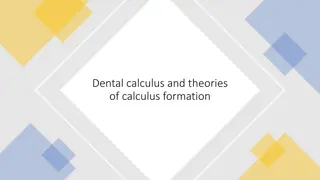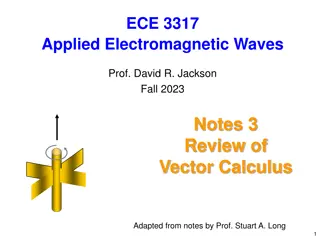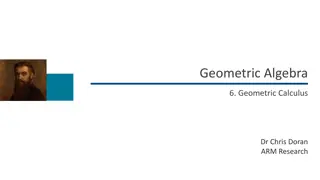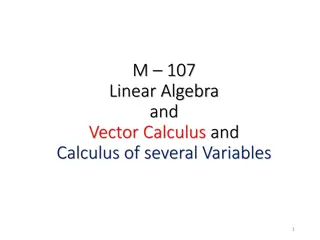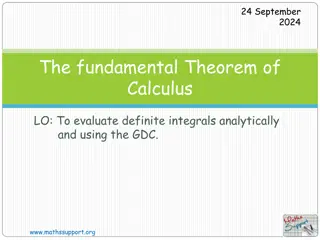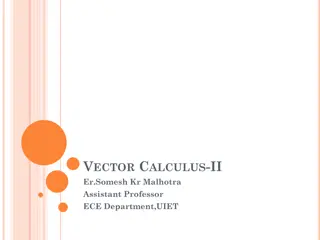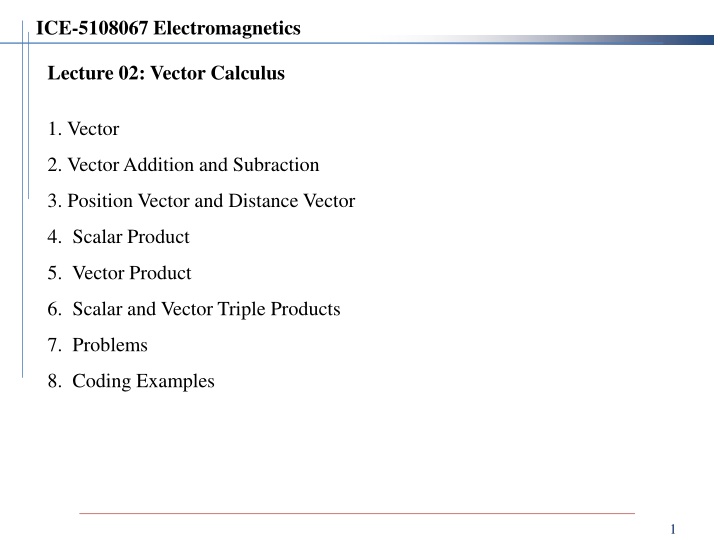
Master Vector Calculus with Electromagnetics: Lecture Overview
Dive into vector calculus basics including vector notation, addition, subtraction, scalar and vector products, and practical exercises in this Electromagnetics lecture series. Enhance your understanding of vectors and their applications in electromagnetics.
Uploaded on | 2 Views
Download Presentation

Please find below an Image/Link to download the presentation.
The content on the website is provided AS IS for your information and personal use only. It may not be sold, licensed, or shared on other websites without obtaining consent from the author. If you encounter any issues during the download, it is possible that the publisher has removed the file from their server.
You are allowed to download the files provided on this website for personal or commercial use, subject to the condition that they are used lawfully. All files are the property of their respective owners.
The content on the website is provided AS IS for your information and personal use only. It may not be sold, licensed, or shared on other websites without obtaining consent from the author.
E N D
Presentation Transcript
ICE-5108067 Electromagnetics Lecture 02: Vector Calculus 1. Vector 2. Vector Addition and Subraction 3. Position Vector and Distance Vector 4. Scalar Product 5. Vector Product 6. Scalar and Vector Triple Products 7. Problems 8. Coding Examples 1
1. Vector Vector: - Magnitude and direction - Vector notation: roman bold - Magnitude notation: italic =A = = A A A A | | ; A A A : unit vector A : magnitude A = + + = A x y z ( , , ): component notation A A A A A A x y z x y z 2 x 2 y 2 z = + + A A A A 2
1. Vector Vector component notation: Unit vector ( ): - B = B 3
1. Vector Exercise: Find the magnitude of a vector A = (1, 5, 3). Find the unit vector of a vector A = (1, 5, 3). 4
1. Vector Exercise: 5
2. Vector Addition and Subtraction Vector Addition: = + + = + + A x y z B x y z ; A A A B B B x y z x y z = + = + + + + + C A B x y z ( ) ( ) ( ) A B A B A B x x y y z z Vector Subraction: = + + = + + A x y z C x y z ; A A A C C C x y z x y z = = + + B C A x y z ( ) ( ) ( ) C A C A C A x x y y z z 6
2. Vector Addition and Subtraction Exercise: Express the vector C using vectors A, B, and E. Express the vector E using vectors A, B, and C. 7
3. Position Vector and Distance Vector Position vector: Distance vector: 8
3. Position Vector and Distance Vector Exercise: Find the position vector RPof a point P(1, 5, 3). Find the distance vector RPQfrom a point P(1, 5, 3) to Q(2, 4, 1). 9
4. Scalar Prouct Scalar or dot product: = A B cos AB A B 1 = cos AB = A B A B 0 10
4. Scalar Prouct Scalar product : - - - - 11
4. Scalar Prouct Exercise: A triangle has vertices A(3, 2, 2), B(5, 4, 3), and C( 1, 6, 5) Find the base length RAB= |RAB|. Find the height with RABas the base. Find the interior angle at the vertex A. 12
5. Vector Prouct Vector or Cross Product: - Right-hand rule = n A B sin AB = B A A B = A A 0 = = = x x y y z z 0, 0, 0 = = = x y , z y z , x z x y x y z = A B A A A x y z = x y z B B B x y z = + + x y z ( ) ( ) ( ) A B A B A B A B A B A B y z z y z x x z x y y x 13
5. Vector Prouct Lagrange's Identity: 2 2 2 = A B A B | | ( ) ( ) AB (Proof) 2 2 2 2 2 2 2 = = ) (1 cos = A B A B | | ( ) sin ( ) ( ) ( ) AB AB AB 14
5. Vector Prouct Area of a parallelepiped: Area of a triangle: 15
5. Vector Prouct Exercise: - - : r1, r2, ..., rN - P : P = (r1 + r2 + ... + rN ) / N - : S = S1+ S2+ ... + SN 1( 2 = ) ( r r r r ) S + 1 0 0 n n n 16
5. Vector Prouct Exercise: - triangular meshing - . 17
5. Vector Prouct Applications of Vector Product: -A vector perpendicular to two vectors -A vector perpendicular to a plane - Torque calculation: T = R F - Check if two vectors are parallel to each other. -Area of a triangle 18
5. Vector Prouct Exercise: 19
5. Vector Prouct Exercise: 20
5. Vector Prouct Exercise: 21
5. Vector Prouct Exercise: 22
6. Scalar and Vector Tripole Proucts Volume of a parallelepiped ( ): = A B | | : area of parallelogram S A B A B = C : height of parallelepiped H | | = = A B C V SH 25
6. Scalar and Vector Tripole Proucts Volume of a tetrahedron ( ): 26
6. Scalar and Vector Tripole Proucts Exercise: Find the volume of a tetrahedron whose vertices are given by A(0, 4, 1), B(4, 0, 0), C(3, 5, 2), D(2, 2, 5) (Answer) Take the point D(2, 2, 5) as a new coordinate origin. Then vectors A, B, and C define the tetrahedron. = = (0,4,1) (2,2,5) ( 2,2, 4) = A R DA = = (4,0,0) (2,2,5) = (2, 2, 5) B R DB = = (3,5,2) (2,2,5) = C R (1,3, 3) DC = 2 2 4 5 3 1 6 1 3 1 6 = = [ 2(6 15) 2( 6 5) 4(6 + + + A B C | ( )| 2 1 2 2)] V 3 1 6 72 6 = | 42 2 32| + = = 12 27
7. Problems 1. A vector on the xy-plane is given A = (1, 1). Find a unit vector perpendicular to A on the xy-plane. 2. A line A is defined by y = x+1. Find the minium distance from P(3, 2) to A. 3. Find the area of a triangle whose vertices are defined by A(1, 1), B(4, 0), C(3, 3). 4. Find the area of a quadrangle whose vertices are defined by A(1, 1), B(4, 0), C(3, 3), D(0, 1). 5. Find a unit vector perpendicular to A = (2, 1, 3) and B = ( 1, 2, 4). 6. Find the volume of a tetrahedron whose vertices are given by A(1, 1, 2), B(3, 2, 4), C( 2, 1, 3), D(5, 3, 5). 28
8. Coding Examples 1) Given a line A: y = ax + b, and, find a unit vector u parallel to A and a unit vector v normal to A. (Answer) + Two points on : (0, ), ( , A P ) b Q a a b = + ) (0, ) = R ( , a a ( , ) a b b b PQ R 1 PQ = = u ( , ) a b R 2 2 + a b PQ 1 = = v z u ( , ) b a 2 2 + a b 29
8. Coding Examples # EM-Lec1-Vecor_Calculus # unit vector parallel to a line and unit vector normal to a line import math while True: a=float(input('Line:y=ax+b; a=')) b=float(input('Line:y=ax+b; b=')) mag=math.sqrt(a**2+b**2) ux=a/mag; uy=b/mag vx=-b/mag; vy=a/mag print('ux,uy=',ux,uy) print('vx,vy=',vx,vy) ''' Line:y=ax+b; a= 1 Line:y=ax+b; b= 2 ux,uy= 0.4472135954999579 0.8944271909999159 vx,vy= -0.8944271909999159 0.4472135954999579 Line:y=ax+b; a= ''' 30
https://www.online-python.com/ copy [Run] prompt . - ( ) (proof given later) - Open file From Disk Save File to Disk Undo Redo Change Theme About Site 31 Settings
- () (proof given later) - Copy to clipboard: copy ( Ctrl+v ) Download: txt Clear: Smart terminal: >>> interpreter . Python 1 . help(print) help Expand/Collapse: Expand = , Collapse: , 32
8. Coding Examples 2) Given three points with position vectors r1 = (x1, y1, z1), r2= (x2, y2, z2) and r3= (x3, y3, z3), find 1) a vector c = (r2 r1) (r3 r1), 2) the area of a triangle whose vertices are r1, r2, and r3, and 3) unit vectors n1and n2which are normal to the triangle. (Solution) = = = a r r ( , , ) ( , , ) x x y y z z a a a 2 1 2 1 2 1 2 1 x y z = = = b r r ( , , ) ( , , ) x x y y z z b b b 3 1 3 2 3 2 3 2 x y z x y z = a b = = + + c x y z ( ) ( ) ( ) a a a y z a b z y a b z x a b x z a b x y a b a b x y z y z b b b x y z = ( , , ) c c c x y z a b a b 1 2 1 2 1 2 x 2 y 2 z = = + + = = = a b n n n | | ; 2( , , ) ; S c c c c c c 1 2 1 x y z | | 2 x 2 y + + c c c z 33
8. Coding Examples # EM-Lec1-Vecor_Calculus # Three points r1=(x1,y1,z1), r2=(x2,y2,z2) and r3=(x3,y3,z3) # are given. Find 1) a vector c=(r2-r1)x(r3-r1), 2) the area of # a triangle whose vertices are r1, r2, and r3, and 3) unit # vectors n1 and n2 perpendicular to the triangle. import math while True: x1,y1,z1=map(float, input('x1,y1,z1=').split()) x2,y2,z2=map(float, input('x2,y2,z2=').split()) x3,y3,z3=map(float, input('x3,y3,z3=').split()) ax=x2-x1; ay=y2-y1; az=z2-z1 bx=x3-x1; by=y3-y1; bz=z3-z1 cx=ay*bz-az*by; cy=az*bx-ax*bz; cz=ax*by-ay*bx print('c=(r2-r1)x(r3-r1)=(',cx,',',cy,',',cz,')') cmag=math.sqrt(cx**2+cy**2+cz**2) area=cmag/2 n1x=cx/cmag; n1y=cy/cmag; n1z=cz/cmag n2x=-n1x; n2y=-n1y; n2z=-n1z print('Area of the triangle=',area) print('n1x,n1y,n1z=(',n1x,',',n1y,',',n1z,')') print('n2x,n2y,n2z=(',n2x,',',n2y,',',n2z,')') "" x1,y1,z1= 0 4 3 x2,y2,z2= 2 6 1 x3,y3,z2= 3 1 9 c=(r2-r1)x(r3-r1)=( 6.0 , -18.0 , -12.0 ) Area of the triangle= 11.224972160321824 n1=( 0.2672612419124244 , -0.8017837257372732 , -0.5345224838248488 ) n2=( -0.2672612419124244 , 0.8017837257372732 , 0.5345224838248488 ) 34
ICE-5108067 Electromagnetics Lecture 01: Vector Calculus 35

